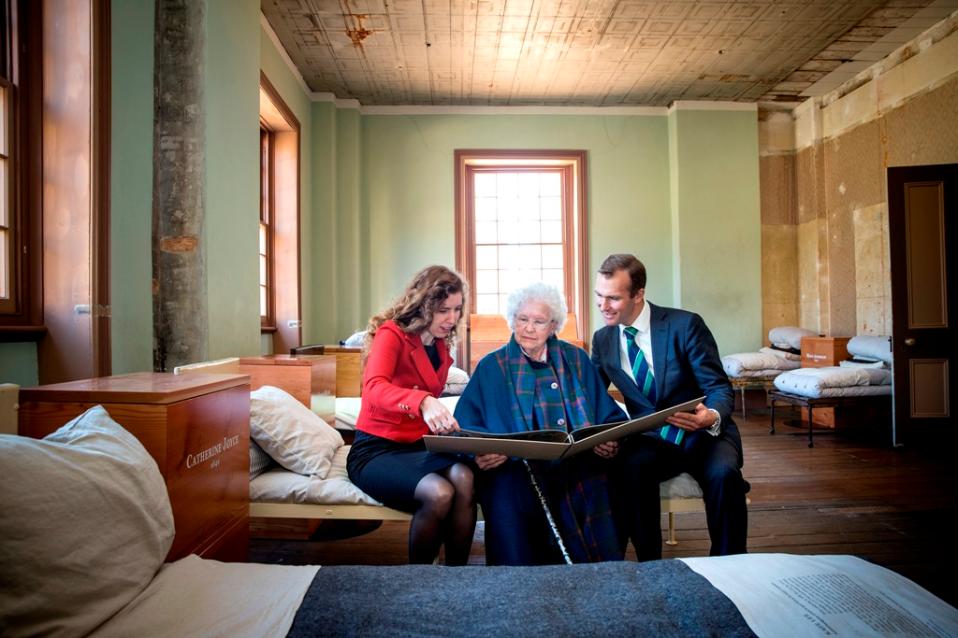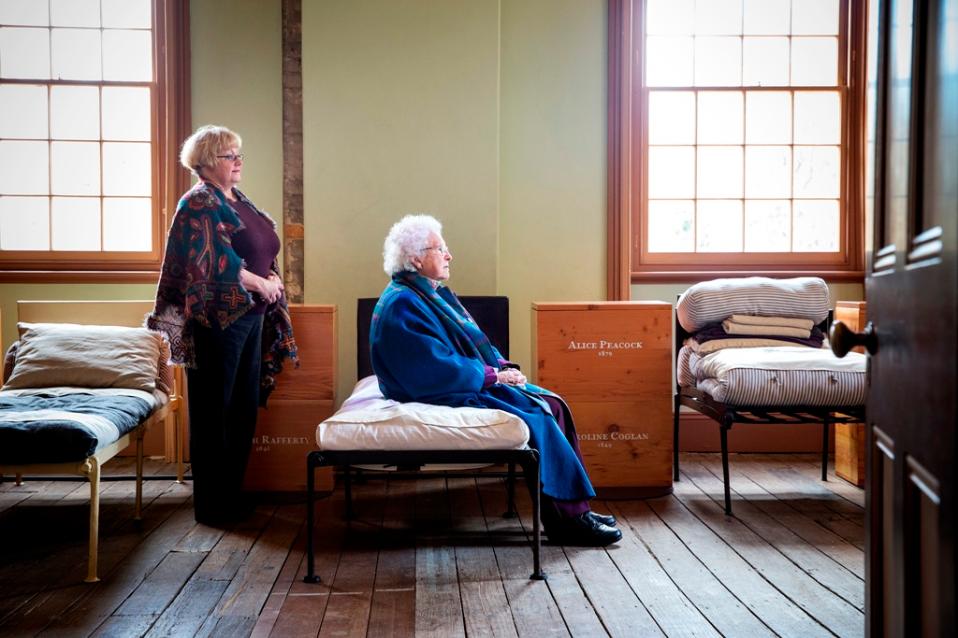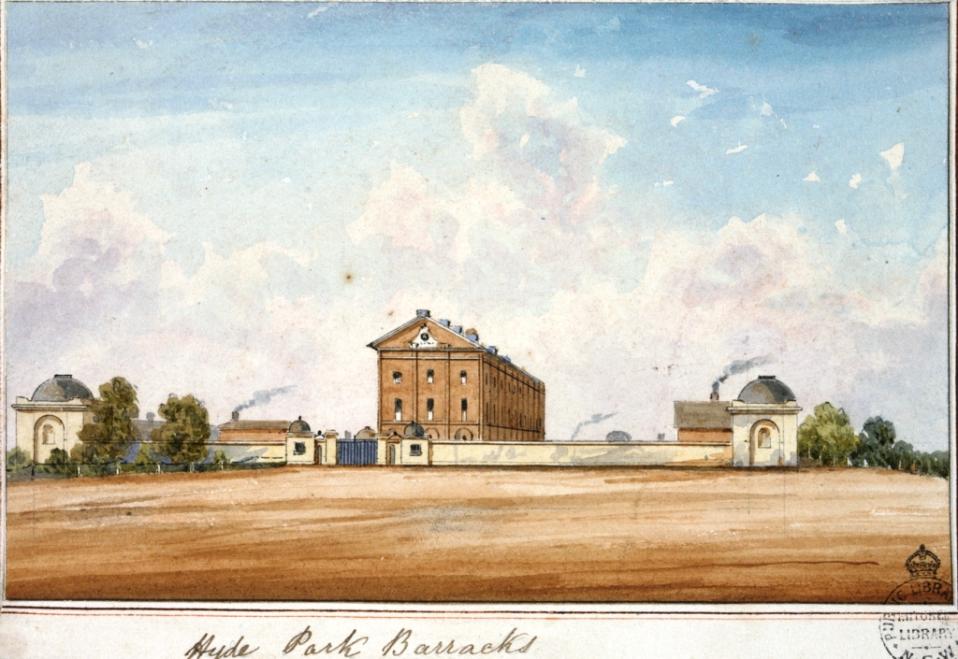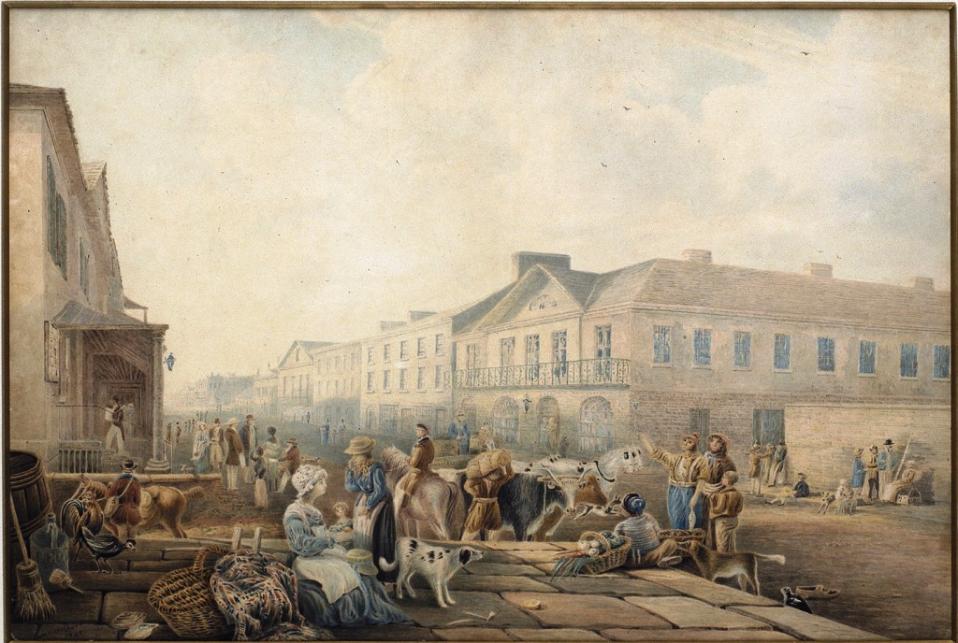July 27 - August 2, 2014: Issue 173
FROM BENEATH THE FLOORBOARDS

Curator Fiona Starr, Barbara Zammit- great granddaughter of Rose McGee (in the exhibit), with Heritage Minister Rob Stokes - Credit: Sydney Living Museums, Photograph © James Horan
FROM BENEATH THE FLOORBOARDS - July 23, 2014
Heritage Minister Rob Stokes has met with descendants of immigrant women who called Hyde Park Barracks home in the 1800s and left behind some 130,000 artefacts that were lost to them beneath the floorboards.
The Minister said it was not well known that the Hyde Park Barracks played an integral role in the history of Australian immigration, providing temporary shelter for around 40,000 female immigrants between 1848 and 1886.
“The women left behind thousands of items, some of which are currently in a display at the Barracks entitled Female Immigration Depot,” Mr Stokes said
“I am delighted to be meeting with descendants of the courageous young women who made the difficult decision to leave their homelands, many very young and alone, to take their chance for a new life in a land of opportunity.
“It is possible that over a million Australians are descended from the original 40,000 women who arrived during this time and called the immigration depot home – illustrating what an incredible contribution these women made in shaping our country.
“The women are long gone, but remnants of their simple belongings have survived, connecting us with the women and allowing us a glimpse into their lives and living conditions.
“Their stories have been pieced together from official records, family research, oral histories, photographs and archaeological artefacts.
“On display are a careful selection of some of the 130,000 items found by archaeologists beneath the floorboards of the barracks such as hair combs, letters, sewing items and jewelry.
“The exhibition also features a family album, inviting other descendants to share their story.”
On the eve of the exhibition launch, two of the direct descendants, Christine Bryan and Barbara Zammit have joined with the Minister to share the story of their relatives.
“The personal stories that Barbara and Christine tell of their great and great-great grandmothers respectively really brings this exhibition of artefacts to life,” Mr Stokes said.
“This exhibition provides a fascinating insight into our early colonial past and highlights the strength of character these women had and the often remarkable lives they led.
“We know there are hundreds of thousands of descendants of these women in the community and Sydney Living Museums is now calling on anyone whose ancestors stayed at the female Immigration Depot to visit the museum, see the new display and connect with their ancestors.”
The exhibition Female Immigration Depot 1848 – 1886 officially opened today.
_______________________________________________
KEY POINTS:
In 1848 the Hyde Park Barracks were transformed into Sydney’s female Immigration Depot, which was much needed due to the increasing numbers of free immigrants arriving in the colony.
For 38 years it provided temporary shelter and a safe haven for immigrant women, some accompanied by their children.
It is estimated that more than 40,000 women stayed at the immigration depot. By day the women waited to be collected by friends or family, or to be employed from the hiring room on the ground floor. At night, they slept on simple iron beds in dormitories.
The dormitory environment the women would have stayed in has been recreated using simple iron beds and wooden trunks that contain selected personal stories and remnants of everyday life that the women left behind at the depot.
Selection of women featured in the exhibition
Rose McGee
Fifteen years old and alone, Rose emigrated to NSW in 1859 with the assistance of the Donegal Relief Fund. She married Norwegian Peter Andersen and went to live in the rural town of Cuppacumbalong, NSW, where she and Peter had nine children. They later settled in Glebe, Sydney. Rose died in Waverley in 1908.
Rose’s descendent, Barbara Zammit (80 years old), attended the opening of the exhibition at Hyde Park Barracks.
Margaret Hurley
Returning to the barracks after more than 160 years to feature in the display, is an original trunk that once belonged to Irish orphan Margaret Hurley. Margaret was one of over 2000 Irish orphans who passed through the depot within its first few years, all victims of the Great Irish Famine.
Just 17 years old, Margaret arrived at the depot in February 1850, and stayed briefly before being employed in Yass as a house servant. Margaret later married, had seven children and lived a long, full life. Shirley Patricia Williams (Pat) a descendant, attended Hyde Park Barracks to meet the Minister.
Catherine Joyce
One of 156 Irish orphans who arrived in Sydney on the Panama in 1850, Catherine stayed a few nights in the Immigration Depot before being apprenticed to Reverend Joseph Oram of York Street. She married Dr R J Stuart-Robertson in South Australia and they had 10 children before he deserted here.
Catherine kept an ornate molded vulcanite cross as a memento of her homeland. The cross, along with her wedding ring, was passed down to her descendants and is now a part of the Hyde Park Barracks Museum Collection and is on display in the exhibition.
Mary Adderley
Mary Ann Adderley along with her sister Jane was accommodated at the Immigration Depot soon after their arrival in Sydney in 1849. Mary, after being dismissed from her employment in Pyrmont for ‘neglect of duty and disobedience’, later moved to Fitzgerald Swamp near Bathurst where she married an English baker.
Together they ran a farm, managed a hotel at Guyong and built their own hotel at Milthorpe, which Mary ran successfully with her thirteen children after her husband’s death. Mary’s descendants still live in the area.
Exhibition launch Date: 23rd July 2014
Hyde Park Barracks: Queens Square, Macquarie Street, Sydney
OPEN DAILY 10AM – 5PM
Tickets: Admission free with museum entry
Adults $10, Children/Concession $5
Families $20, Members free
Further details are available at sydneylivingmuseums.com.au

Two descendants - Credit: Sydney Living Museums, Photograph © James Horan
FEMALE IMMIGRATION DEPOT 1848 – 1886
In this new display at Hyde Park Barracks visitors can lift the lid on the fascinating stories of individual women who passed through Sydney’s Immigration Depot, at the barracks between 1848 and 1886.
World Heritage-listed for its convict history, Hyde Park Barracks has also played an integral role in Australian immigration. In 1848, the barracks was transformed to house Sydney’s female Immigration Depot, much needed due to the increasing numbers of free immigrants arriving in the colony.
For 38 years it provided temporary shelter and a safe haven for an estimated 40,000 immigrant women, some accompanied by their children. By day the women waited to be collected by friends or family, or to be employed from the hiring room on the ground floor. At night they slept on simple iron beds in dormitories. They all made the difficult decision to leave their homelands and take their chance for a new life in a land of opportunity.
In this new display, a handful of individual stories of the immigrant women are pieced together from official records, family research, oral histories, photographs and archaeological artefacts. Simple iron beds also on display, set the scene of the dormitories where the women once stayed, and wooden trunks contain selected personal stories and remnants of every day and precious items the women left behind at the depot.
These artefacts are among 130,000 items found by archaeologists beneath the floors of the main building. The women are long gone, but these remnants of their simple belongings have survived, connecting us with the women and allowing us a glimpse into their lives and living conditions.
Returning to the barracks after more than 160 years to feature in the display, is an original trunk that once belonged to Irish orphan Margaret Hurley. Margaret was one of over 2000 Irish orphans who passed through the depot within its first few years, all victims of the Great Irish Famine. Just 17 years old, Margaret arrived at the depot in February 1850, and stayed briefly before being employed in Yass as a house servant. Margaret later married, had seven children and lived a long, full life.
With hundreds of thousands of descendants of the women in the community today, the Female Immigration Depot display contains a family album, giving descendants the opportunity to share stories.
Perhaps your ancestor stayed here? If so, we’d love to hear from you!

Above: Hyde Park Barracks, Drawings in Sydney, ca. 1840-1850, by Joseph Fowles, Image No.: a623015, courtesy State Library of NSW.
Below: George Street, Sydney - looking south painted by Henry Curzon Allport - January 1842, Image No.: 861739, courtesy State Library of NSW.
